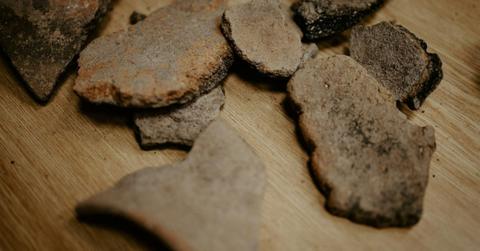Mercurial Monument: Extremely Rare Clay Head of Roman God Found in Nearly 2,000-Year-Old Settlement

Archaeologists in the United Kingdom meticulously combed through dirt, depositing each scoop into their awaiting buckets.
Their mission: to unearth the remnants of a medieval coastal settlement. However, what they stumbled upon was not what they expected — instead, they uncovered the traces of a long-forgotten Roman community, housing an “extremely rare” treasure.
In a recent Facebook post, National Trust Archaeology announced the astonishing discovery of the ancient Roman settlement concealed beneath a medieval shipyard at Smallhythe Place.
Dating back over 1,700 years, from the first to the third century A.D., this settlement emerged from the depths of history.
Archaeologist Nathalie Cohen shared insights into the findings, which included tiles marked with the insignia of the Roman fleet, or the Classis Britannica, as well as intact pottery, and various structural remnants indicating buildings, boundaries, and pits. To see the photos of the artifacts, click here.
However, amidst the artifacts, one particular item stood out — a small clay head, roughly two inches in height.
Identified as part of a pipeclay figurine portraying the ancient Roman god Mercury, the discovery sparked excitement within the archaeological community.
Describing the significance of the find, Cohen remarked, “To come across a head of a figurine of Mercury, in pipeclay, is incredibly rare,” the Miami Herald reported.
Mercury, revered in ancient Roman culture as the god of fine arts, commerce and trade, was commonly depicted in metal figurines. Yet, examples crafted from pipeclay are exceedingly scarce, with fewer than ten known to exist in Roman Britain.
Matthew Fittock, an expert in ancient Roman ceramics, shed light on the purpose of such figurines, explaining their role in private religious practices within domestic shrines, temples and sometimes even in the graves of children.
Never miss a story — sign up for the Front Page Detectives newsletter. Be on the scene the moment news breaks.
He noted the ritualistic significance of deliberately breaking some figurine heads, suggesting a cultural practice.
Notably, the discovery of the pipeclay head of Mercury lacked accompanying fragments, leaving archaeologists to speculate on its original form. The National Trust suggested that the complete figurine likely depicted Mercury standing, adorned with a chlamys or holding a caduceus.
The pipeclay head and other Roman artifacts will be showcased at Smallhythe Place, offering visitors a glimpse into the rich history of this ancient settlement. Situated in Kent, approximately 50 miles southeast of London, Smallhythe Place now stands as a testament to the enduring legacy of the past.
Become a Front Page Detective
Sign up to receive breaking
Front Page Detectives
news and exclusive investigations.
